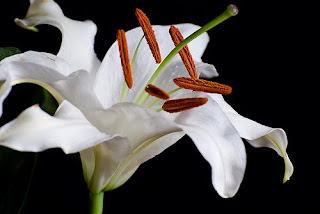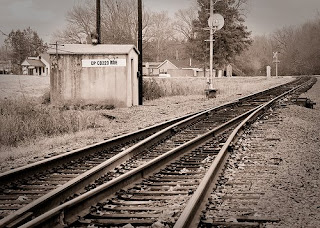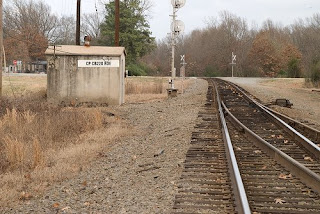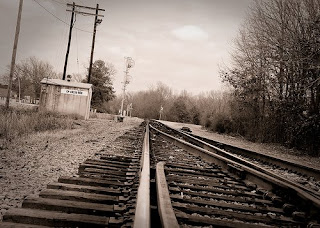I took a day off from work last Friday and went to Hawksbill Crag and The Glory Hole. The girls were in California on a trip they had planned for a couple of months. I had been planning this trip for the same couple of months. The original plan was that I’d hike around for the day, go to White Rock and get a cabin, and then do some more hiking on Saturday. Then, I saw that the Wakarusa Music Festival was going on, and decided that even if there was a cabin available I didn’t want to get near the traffic associated with a music festival. As it turns out, Saturday would have been out of the question; Friday was exhausting (in a good sort of way).
I have a tendency to be a night owl. I’d rather stay up late than get up early. For someone who also loves nature photography, that’s a bit of a problem. The night owl bug strikes especially when the girls are gone, and Thursday night was no exception. When the alarm went off at 4:30 a.m., I was hurting. I piddled around for 30 minutes, trying to wake up and packing some gear. I left the house around 5:00 a.m., and figured I’d better get some breakfast. Hello, Waffle House (my favorite). It took forever. I left Waffle House about 5:30 or so, and got to the parking area at the Hawksbill Crag trail head about 7:45, stopping only in east Springdale for gas and water. Interestingly, Willie Nelson has a line of bottled water. What could be more American than a hike in the woods with Willie Nelson? Besides, what do you think Willie puts in his water? Two bottles, please.
I could have made it out there more quickly, but the fog was pretty brutal heading out Hiway 412. By 7:45, the light was pretty harsh. By packing all my gear the night before, and by grabbing breakfast on the go, I could have been there at 6:45, which would have been better. Frankly, if I had to do it over again, I’d get there well before sunrise and hike in with a flashlight. Sunrise happened to be around 5:55 a.m. or so Friday morning. It took 45 minutes to hike to the Crag (in daylight), so I would have had to leave about 4:00 a.m. Yikes. Maybe I’ll rent the Cave Mountain Guest House next time. (Don’t laugh—it had a front porch and rocking chairs.) The scene at 8:30 when I got to the top of the Crag was breathtaking. The light sucked.
The hike in was easy enough. The only challenge was the occasional tree across the trail, but pretty simple otherwise. There are two trails—an upper trail and a lower trail. I understand the higher trail is shorter, but the lower trail is more scenic because it skirts the bluff. The trails are marked by little orange markers nailed to the trees. Just about when you think maybe you’ve gone too far and missed it, you see the Crag from a little landing about 35 yards away. The top of the rock itself doesn’t feel all that big. What’s hard to describe is how incredible the view is from the top. You are standing on outcropping of rock about 100 feet off the ground, surrounded by a vast expanse of forested mountains. The weather was perfect—sunny and still a little cool. So I just sat there for a while. I was the only soul out there. It was so peaceful. Earlier, I had updated my Facebook status to indicate that I was headed to the Crag, and it occurred to me to update it again upon my arrival. So, I grabbed my BlackBerry out of my backpack. The message it gave me was a not-so-subtle reminder about the point of this daytrip: “There is no data signal available.” In fact, I had no signal until about 3:30 that afternoon. Freedom from the digital leash! So, Willie Nelson and I sat up on Hawksbill Crag and shared some water.
 As for the photograph, well the light was pretty well horrible, but I knew I had to take the obligatory shot of the Crag just to prove I’d been there. I went back to the little landing, put my camera on the tripod, and wrapped my camera strap around a nearby tree. (I can’t imagine telling my insurance agent that my camera broke because I set it up on the edge of a 100-foot drop-off unsecured—and then a bird landed on it and tipped it over.) Fired off a few shots, fiddled with the exposure, cursed myself for not getting there earlier, fiddled again, deleted most everything I shot, cursed some more. Then I remembered that big-ass heavy camera bag I brought with me, and grabbed a 3-stop graduated neutral density filter out of the bag, fitted it to my lens and set the bottom of the split at the bottom of sky. I was shooting pretty much right into the sun, so the circular polarizer would have done nothing as far as eliminating glare. Best I could manage under the circumstances. I shot this with a black and white conversion in mind, which was done in Lightroom 2.3. I haven’t worked on doing localized adjustments in LR, so I went to Photoshop Elements and dodged the Crag quite a bit and then burned back in a few edges. (After I typed this, I did make some localized adjustments in LR just for yucks.)
As for the photograph, well the light was pretty well horrible, but I knew I had to take the obligatory shot of the Crag just to prove I’d been there. I went back to the little landing, put my camera on the tripod, and wrapped my camera strap around a nearby tree. (I can’t imagine telling my insurance agent that my camera broke because I set it up on the edge of a 100-foot drop-off unsecured—and then a bird landed on it and tipped it over.) Fired off a few shots, fiddled with the exposure, cursed myself for not getting there earlier, fiddled again, deleted most everything I shot, cursed some more. Then I remembered that big-ass heavy camera bag I brought with me, and grabbed a 3-stop graduated neutral density filter out of the bag, fitted it to my lens and set the bottom of the split at the bottom of sky. I was shooting pretty much right into the sun, so the circular polarizer would have done nothing as far as eliminating glare. Best I could manage under the circumstances. I shot this with a black and white conversion in mind, which was done in Lightroom 2.3. I haven’t worked on doing localized adjustments in LR, so I went to Photoshop Elements and dodged the Crag quite a bit and then burned back in a few edges. (After I typed this, I did make some localized adjustments in LR just for yucks.)
After that, I decided it would be cool to try and get a picture of myself on top of the Crag. Unfortunately, the longest shutter delay setting on my camera is 20 seconds, and the run to the Crag from where I was set up was about 23 seconds. In shooting some stuff at The Glory Hole, I figured out how to buy a few seconds (but you’ll have to wait for that post for the tip). After giving up, I headed back to Haley Falls and shot what little water there was and some little purple wildflowers—stay tuned for the next post.
 Wow. Here it is, November 1st. The card that is in my camera has pictures on it from April that I haven't imported. Summer is full of a lot of things. Heat. Rain. Vacations. Sports. My summer was full of work, and not at all full of photography.
Wow. Here it is, November 1st. The card that is in my camera has pictures on it from April that I haven't imported. Summer is full of a lot of things. Heat. Rain. Vacations. Sports. My summer was full of work, and not at all full of photography.



















